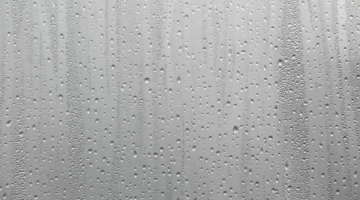
With such uncertain weather these days, condensation is a problem that many of us are facing. Apart from ruining the view from your windows, condensation can damage window frames and sills, and cause serious mould issues. Double glazing is often touted as the cure, but it’s certainly not the cheapest way to stop condensation, and for many people replacing their windows entirely is simply not an option.
Improve Ventilation
Condensation occurs when water vapour reaches its dew point on a cold surface, turning it to liquid. The reason we see on it windows in winter and not the summertime is that the cold weather of winter is what causes the glass to be cold enough for the water vapour to condense on. Add this to the heating we have on all winter, which serves to help the water evaporate into the air, and the fact that we tend to draught proof like our lives depend on it.

The solution is simple and inexpensive; let the room breathe. Opening a window just a little will make a huge difference, or if you have window vents then make sure there’s nothing blocking them. If you’re willing to do a little more work and spend a little money, air bricks can be added to outside walls, or air vents added for internal walls.
Dehumidification
Damp trap
The idea behind damp traps is that the little box will suck up the moisture that would otherwise condense on the windows and collect it there. Reviews are very mixed, but some people swear by them.
I picked mine up in Poundland, so with this one when I say that they’re cheap I really do mean cheap (£12.49 for a pack of 10 on Amazon), but there’s a certain level of false economy. Each damp trap is single use, meaning that you have to replace them constantly. Even though they’re cheap to purchase, the cost mounts up.
Constantly replacing them also means a whole lot of plastic wastage; something we’re not fans of.
Dehumidifier
A dehumidifier is a clever little box that sucks in the air and condenses the water from it before releasing it back out. They’re great at what they do, though the higher end models can be a big expenditure.
They use electricity so they’re certainly not the cheapest option in terms of long term cost, though there are some A-rated efficiency models out there (£119.99 on Amazon). That said, they certainly do the job.
Secondary Glazing
While double glazing may not be an option for cost or logistical reasons, secondary glazing can be a much cheaper option and one of the most cost effective ways to tackle condensation.
Ecoease secondary glazing is not made from glass but from PET (a type of super strong thermoplastic polymer resin), which is 5 times more effective than glass at preventing the transfer of heat. This means that it creates a warm barrier against the cold glass and the water vapour, preventing the condensation process from happening.
At £115 per meter squared, Ecoease is around 85% cheaper than traditional double glazing. It’s also ideal for listed buildings that might be restricted by planning permissions, and character properties that might otherwise be forced to sacrifice period glazing features for the sake of thermal comfort and ridding themselves of condensation issues.
If you’re interested, you can get a free sample of Ecoease secondary glazing on their website.
Think we missed something? Do you have a different opinion?
Comment below to get your voice heard…











intersting article but you don’t cover double glazing…?
Hi Mike,
We decided not to go with traditional double glazing as we were exploring cheaper options here. We wouldn’t really consider double glazing to be a cheap solution!
Thanks
Harri
I have terrible condensation only on the outside of my downstairs windows. Is this because I dont put the heating on as due to health reasons I tend to spend most of my time in the bedroom and hardly ever put the heating on downstairs. Much appreciate your advice please
Was in a supermarket recently at the Pet area.Elderly Gent was buying 10 kg cat litter- said it was to top up Dehumidifiers! Reckoned it worked for him last Winter. Also said final wipe over with Meths when cleaning interior glazing minimises moisture too.